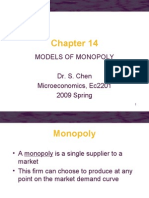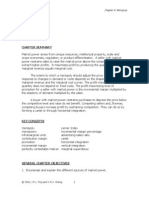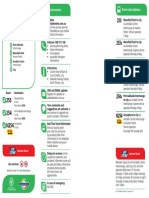Chapter 10 Market Power - Monopoly
Uploaded by
KaranChapter 10 Market Power - Monopoly
Uploaded by
Karan📄
Ch 10: Market Power- Monopoly
Monopoly - One seller, multiple buyers
Monopsony - Multiple sellers, one buyer
Market Power- Ability of a seller or buyer to affect the price of a good.
Monopoly
To maximize profit, the monopolist must first determine its costs and the
characteristics of market demand.
Average Revenue and Marginal Revenue
Marginal revenue: Change in revenue resulting from a one unit
increase in output.
The monopolist’s average revenue—the price it receives per unit sold—is precisely
the market demand curve. (Average Revenue is the Market Demand Curve-
because there is only seller- he is fulfilling all demand)
P = 6-Q
Ch 10: Market Power- Monopoly 1
When marginal revenue is positive, revenue is increasing with quantity, but when
marginal revenue is negative, revenue is decreasing.
When the demand curve is downward sloping, the price (average revenue) is
greater than marginal revenue because all units are sold at the same price.
(because
If sales are to increase by 1 unit, the price must fall. In that case, all units sold, not
just the additional unit, will earn less revenue.
The relationship- MR lies exactly halfway the AR and vertical axis, at the point
where MR intersects the horizontal axis, if a line is drawn, this is the midpoint of the
demand curve, where elasticity is equal to 1.
The Monopolist's Output Decision
A firm must set output so that marginal revenue is equal to marginal cost.
Ch 10: Market Power- Monopoly 2
MR = MC at Q*, if the monopolist produces before Q* then MR is higher than MC,
therefore there is scope to produce more and get more profits
After Q*, MR is lower than MC, which means that the company is producing at a
loss, so they will have to stop producing from Q*-Q2
Here, the monopolist at Q1 gets a higher price but the demand remains less, so its
not ideal- its total output will be smaller in profit than the shaded area
P* is greater than AC, so the profit is the (P*-AC at the profit maximisation point) *
Q*
Ch 10: Market Power- Monopoly 3
In the yellow shaded triangle between Qi and Q*, it indicates the potential profit the
company is foregoing by not producing till Q*, and in the yellow triangle between Q*
to Q2 indicates the loss incurred by cost being more than revenue
∏ = Profit
∏ (Q) = R (Q) - C (Q) [Where the profit curve reaches a peak]
As Q is increased from zero, profit will increase until it reaches a maximum and then
begin to decrease
10.3
Example of Profit Maximisation
Ch 10: Market Power- Monopoly 4
Revenue starts increaing and then peak and then fall
Cost has fixe cost and then slowly increases
Peak- Gap between Revenue and Cost is the greatest
Tangent to the revnue and cost curve at Profit maximisation point- SLope of MR=
Slope of MC
Profit falls because:
Ch 10: Market Power- Monopoly 5
MR falls as Demand curve is downward sloping because of Diminishing
marginal utility
MC falls as there is Diminishing marginal returns
The slope of the revenue curve is ∆R/∆Q, or marginal revenue,
and the slope of the cost curve is ∆C/∆Q, or marginal cost.
Because profit is maximized when marginal revenue equals marginal cost, the
slopes are equal.
The point of profit maximisation is at 10 quantity units where the cost (where the
Average Cost curve intersects 10- here the imaginary line) is 15 and revenue
(where the AR curve- demand curve intersects the output 10, here the imaginary
line) is 30
Thus average profit is 30-15= 15
Area of the shaded triangle is the total profit of 15*10= 150
Cost of production: TC= C (Q) = 50 (fixed cost) + Q2 (Variable cost)
MC= 2Q
Demand: TR= P (Q)= 40 - Q [Demand and MR have the same intercept, MR lies
halfway of the demand and vertical axis]
PQ= R = 40Q - Q2
MR= 40 - 2Q [So the slope here becomes 2Q]
MR= MC
40-2Q= 2Q
40= 4Q
q=10
P+ 40 - Q= 40 - 10+ 30
AR- is nothing but price= 30= P
AC= C/Q= 50+Q2 /Q= 50/Q + Q
Ch 10: Market Power- Monopoly 6
A rule of thumb for Pricing (downward demand curve- in order to
increase sales lower price)
Estimating price when we don't know MR, MC and all the crap:
In this case, the markup over MC depends on the elasticity of demand
if the elasticity is say more than 1, say 2 i.e highly elastic then
P= MC/ 1+ (1/-2) i.e MC/2
If elasticity is less than 1, i.e the good ka demand is inelas
Shifts in Demand
The Effect of a Tax
Specific Tax- tax per unit
MC= MC + t
Ch 10: Market Power- Monopoly 7
MC is constant for simplicity
Tax is added and it shifts the MC cure up
MC intersects MR at a lower quantity and a higher price (price increases greater
than the tax)
The Multiplant Firm
Step 1: MC in X plant is lower than MC in Y plant, then output in Y will keep
decreasing and X will keep increasing until they are equal- the MC in both the plants
are equal
Step 2: Sold in the market such that MC= MR
Monopoly power
Imperfectly competitive markets- firms have some degree of pricing power-
monopoly- highest
Ch 10: Market Power- Monopoly 8
Firm A is likely to face a demand curve which is more elastic than the market
demand curve, but which is not infinitely elastic like the demand curve facing a
perfectly competitive firm.
Production, Price and Monopoly Power
Measuring Monopoly Power
Lerner Index of Monopoly: Power Measure of monopoly power calculated as excess
of price over marginal cost as a fraction of price.
For the competitive firm, price equals marginal cost; for the firm with monopoly
power, price exceeds marginal cost.
Therefore, a natural way to measure monopoly power is to examine the extent to
which the profit maximising price exceeds marginal cost.
Calculated as L= (P - MC)/P
Ch 10: Market Power- Monopoly 9
For a perfectly competitive firm, P MC, so that L 0. The larger is L, the greater is the
degree of monopoly power.
Note that considerable monopoly power does not necessarily imply high profits.
Profit depends on average cost relative to price. Firm A might have more monopoly
power than Firm B but earn a lower profit because of higher average costs.
The Rule of Thumb for Pricing
Ed is the elasticity of demand for the firm, not the elastic of market demand
Sources of Monopoly Power
Three factors determine a firm’s elasticity of demand.
1. The elasticity of market demand: Because the firm’s own demand will be at least as
elastic as market demand, the elasticity of market demand limits the potential for
monopoly power.
2. The number of firms in the market. If there are many firms, it is unlikely that any one
firm will be able to affect price significantly.
3. The interaction among firms. Even if only two or three firms are in the market, each
firm will be unable to profitably raise price very much if the rivalry among them is
aggressive, with each firm trying to capture as much of the market as it can.
The Elasticity of Market Demand
Several firms compete with one another; then the elasticity of market demand sets a
lower limit on the magnitude of the elasticity of demand for each firm
Ch 10: Market Power- Monopoly 10
Hence, the elasticity of an individual firm is generally more than the market
elasticity, but the market elasticity sets the minimum limit
The Number of Firms
Ceteris Paribus, the monopoly power of an individual firm falls as the number of
firms increase, and rises as the number of firms decreas
This is because more firms means more competition
What matters, of course, is not just the total number of firms, but the number of
“major players”
So to keep elasticity low, they may create barriers to entry
An important aspect of competitive strategy (discussed in detail in Chapter 13)
is finding ways to create barriers to entry—conditions that deter entry by new
competitors.
Interaction Among Firms
Natural Monopoly- For its entire range of output, AC is falling- its better to have one firm
not many- firms will split up the market- each firm will have higher AC
Regulation in Practice
R= rK + D
rK means the rate of return gov is giving on capital as per what it deems fit, and then
deprecitation is added
Regulatory lag- a price which gives a firm regulatory rate of return- however the
chnages has to be made quickly- regulatory returns could be higher or lower
Ch 10: Market Power- Monopoly 11
Anti Trust Laws- Rules and Regulations prohibiting actions that restrain, or are likely to
restrain, competition
Horizontal Agreements- joint ventures
Intertemporal and Peak Load Pricing
Ch 10: Market Power- Monopoly 12
You might also like
- Rajwant Singh v. State of Kerala, AIR 1966 SC 1874No ratings yetRajwant Singh v. State of Kerala, AIR 1966 SC 18745 pages
- Microeconomics: by Robert S. Pindyck Daniel Rubinfeld Ninth Edition100% (1)Microeconomics: by Robert S. Pindyck Daniel Rubinfeld Ninth Edition56 pages
- Bab 10 Kekuatan Pasar (Monopoli Dan Monopsoni)No ratings yetBab 10 Kekuatan Pasar (Monopoli Dan Monopsoni)37 pages
- Market Power: Monopoly and Monopsony: Prepared byNo ratings yetMarket Power: Monopoly and Monopsony: Prepared by50 pages
- Market Power: Monopoly and Monopsony: Prepared byNo ratings yetMarket Power: Monopoly and Monopsony: Prepared by50 pages
- Market Power: Monopoly and Monopsony: Chapter OutlineNo ratings yetMarket Power: Monopoly and Monopsony: Chapter Outline18 pages
- Eco2211 Microeconomics Chapter 10 SlidesNo ratings yetEco2211 Microeconomics Chapter 10 Slides18 pages
- Market Power: Monopoly and Monopsony Market Power: Monopoly and MonopsonyNo ratings yetMarket Power: Monopoly and Monopsony Market Power: Monopoly and Monopsony59 pages
- Microeconomics X - Monopoly: Gergely HajduNo ratings yetMicroeconomics X - Monopoly: Gergely Hajdu35 pages
- MGMT-5245 Managerial Economics: Market Power: MonopolyNo ratings yetMGMT-5245 Managerial Economics: Market Power: Monopoly22 pages
- Insurance Web Aggregator Regulations, 2017No ratings yetInsurance Web Aggregator Regulations, 20177 pages
- Digital Payments Security Controls 2021No ratings yetDigital Payments Security Controls 202122 pages
- Guidelines for Licensing of Payment BanksNo ratings yetGuidelines for Licensing of Payment Banks12 pages
- Directions for Opening and Operation of Accounts andNo ratings yetDirections for Opening and Operation of Accounts and9 pages
- Shrimoyee Ghosh. "Not Worth The Paper It's Written On' Stamp Paper Documents and The Life of Law in India100% (1)Shrimoyee Ghosh. "Not Worth The Paper It's Written On' Stamp Paper Documents and The Life of Law in India27 pages
- Madan Lal v. State of Jammu and KashmirNo ratings yetMadan Lal v. State of Jammu and Kashmir14 pages
- Fagan v. Commissioner of Metropolitan PoliceNo ratings yetFagan v. Commissioner of Metropolitan Police5 pages
- Koppula Venkata Rao v. State of Andhra PradeshNo ratings yetKoppula Venkata Rao v. State of Andhra Pradesh5 pages
- Dahyabhai Chhaganbhai Thakkar v. State of GujaratNo ratings yetDahyabhai Chhaganbhai Thakkar v. State of Gujarat10 pages
- Types, Properties and Uses of Hypalon: Compounding IngredientsNo ratings yetTypes, Properties and Uses of Hypalon: Compounding Ingredients18 pages
- (123doc) Bai Tap Mon Tieng Anh Kinh Te Quoc Te Reply and QuotationNo ratings yet(123doc) Bai Tap Mon Tieng Anh Kinh Te Quoc Te Reply and Quotation6 pages
- Report On CS TRAINEE DRIVE-2019 Organised at ICSI House, NoidaNo ratings yetReport On CS TRAINEE DRIVE-2019 Organised at ICSI House, Noida3 pages
- VOPAK-Reatile AQIA 13614921-13289-4 - VSAD - RB - DEIAR - Rev0-Ph - 1 PDFNo ratings yetVOPAK-Reatile AQIA 13614921-13289-4 - VSAD - RB - DEIAR - Rev0-Ph - 1 PDF69 pages
- 1chemistry of Consumer Products (Autosaved)No ratings yet1chemistry of Consumer Products (Autosaved)37 pages
- Transformer Room Ventilation Calculation 20170310xlsx - CompressNo ratings yetTransformer Room Ventilation Calculation 20170310xlsx - Compress1 page
- Site Inspection and Maintenance: Physical Inspection Data CollectionNo ratings yetSite Inspection and Maintenance: Physical Inspection Data Collection40 pages
- Communication System II: Lecture-4 Angle ModulationNo ratings yetCommunication System II: Lecture-4 Angle Modulation23 pages























































































































